How To Repair Water Splash Upon Exterior Walls
Waterproofing Brickwork and Damp Proofing External Walls
A guide to waterproofing brickwork and preventing water and moisture ingress to properly damp proof your external walls. Too learn how to check your walls for faults and repair any impairment if you find whatever.
Here at DIY Md we have been searching loftier and low for a brick waterproofer that volition make clammy proofing external brick walls easy without stopping the brickwork animate.
A great many of our users have emailed us with questions on how best to undertake external brick waterproofing, and in the past we've advised you to not apply an exterior damp proof paint unless its makers could promise that it would allow the brickwork to breathe, allowing the clammy in your walls to dry out rather than trapping it in the walls. Such a waterproofer at present exists and we are happy to be able to tell you about it.
If y'all would like whatever boosted advice on the waterproofing of external walls and damp solutions, Property Repair Systems are available. Give them a phone call on 01626 872 650. All advice is gratis of charge and with no obligations.
Waterproofing Your Exterior Brick Walls Helps Solve any External Clammy Issues
When your external walls are exposed to a water source such as pelting, this water can enter your masonry, in some cases travelling laterally from your external walls to your internal walls.
It may exist that cracks in your bricks or pointing are letting the water in, or your prevailing atmospheric condition conditions may just mean that your walls stay damp without getting the opportunity to dry out.
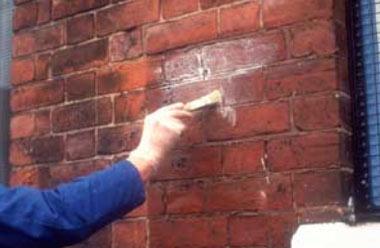
Dryseal waterproofer is one of the all-time ways to go along your masonry waterproof
The Consequences of External Damp
Any cracks in your pointing and brickwork can cause a difference in the water absorbency of different areas of your walls – some areas will blot more water than others. This can course damp patches in what is known equally penetrating dampness.
Alternatively, it tin be that some areas of your wall are more exposed or more susceptible to letting water in, despite beingness sound, and this can also crusade damp patches to class, or a large, uniformly clammy area. This tin can spread to your internal walls too, resulting in patches of clammy on your internal walls.
These patches might contain 'salts' which have washed out of the brickwork and which form white, crunchy deposits which tin can erupt through your pigment and blow your plaster.
The damp patches can besides be 'common cold spots' on your wall, equally clammy patches on your wall lose oestrus 3 times faster than the surrounding wall. These cold spots tin can crusade more moisture from your internal air to form condensation, making the area even damper and encouraging the development of black mould spots.
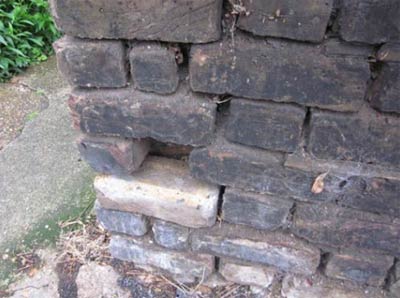
Missing bricks and cracks in masonry can allow damp into the wall
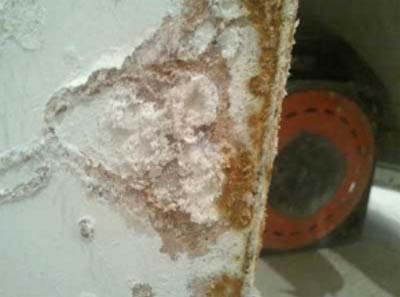
Damp walls can cause common salt deposits to appear – these can accident your plaster
In terms of damage to your external walls, if any h2o that has gotten into your brickwork freezes, information technology will aggrandize outwards within the brick, creating cracks (or more cracks) in your brickwork. This is chosen Feeze-Thaw action, which allows more h2o in, gradually making the trouble worse and destabilising the face up of your brickwork – this is known every bit spalling.
Mould and moss can likewise grow on clammy areas on your outside walls, which can also damage the face of your brickwork.
Other Causes of Damp in Your Walls
If you lot call up your damp bug may exist caused past water coming in from the ground in the grade of rising clammy, cheque out our Ascent Damp project page which discusses installing a horizontal Damp Proof Class in your walls to limit this.
If your damp issues are occurring around window or door frames, check out our Vertical Damp Proof Course project page instead for information on damp proofing effectually window and door frames.
If your interior floors are below ground level, meaning that a significant proportion of your interior wall is below your damp proof course and you're having damp issues in this area, cheque out our Tanking project folio which will evidence you how to waterproof or 'tank' this internal wall expanse.
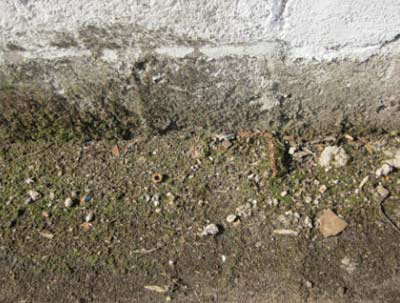
If your damp is affecting the lower area of your wall it may be being caused by Rising Damp rather than External Damp
Checking Your Wall for Faults
There are many reasons why your external brick walls might be getting damp, and not all of these problems can be solved by using a brick waterproofer.
A waterproofer is normally simply used every bit a solution for sound external walls that are exposed to plenty rainfall that they just get clammy – if water is getting into the walls because of a error of some kind, such equally cracks in your bricks or pointing, then you lot will need to fix this before applying any waterproofer – in this case, once you have fixed the issue you can apply waterproofer as a preventative measure out against future impairment.
There are a few reasons why your masonry may have faults – and each of these causes will accept its own solution, which nosotros will discuss hither. There are a few checks that y'all can carry out to place any places in your brickwork where water may be coming in, and too to identify the crusade of these faults.
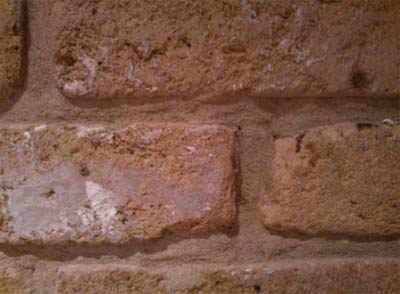
Bank check your external walls for any faults that may be letting damp in to your external walls
Rusted or Dirty Wall Ties
If you lot have cavity walls, there are ties between them securing the inner and outer walls together and providing stability which can rust over time, causing them to expand and crack your brickwork and mortar. These cracks then allow water into the brickwork from exterior, creating clammy patches in your walls.
Wall ties can become dirty when mortar is dropped onto them during the building procedure – this is a problem because they can act as a span for clammy that has accumulated in an external wall to travel across the crenel to the internal wall, again creating a clammy or cold patch.
You lot tin cheque for rusted or muddied wall ties by using a metallic detector on your outside wall wherever your clammy issues are or wherever you tin spot faulty brickwork.
If you lot do find a wall necktie near the affected area you can check its condition past removing the bricks from the external surface area near the tie (do not remove more than two without consulting with a surveyor) – more data on how to remove these bricks is available in our Replacing a Brick project.
Once y'all have removed your bricks, you tin can check your necktie – if information technology is rusted or dirty y'all can either clean it or supersede it – information on how to supervene upon the necktie is available on our Replacing a Wall Tie project. Once yous have replaced your wall tie you can put your bricks back and repoint them – guidance on how to practice this is again available in our Replacing a Brick project linked in a higher place.
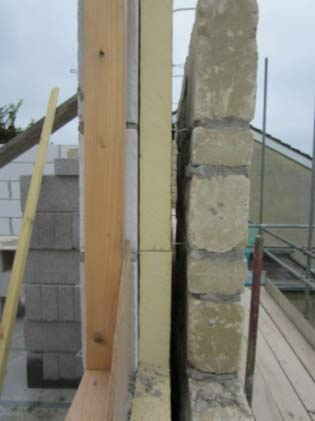
Cheque your wall ties for rusting and clay as this may be assuasive damp to travel through your walls
Cracks acquired by spalling
As mentioned above, if a lot of h2o gets into your brickwork and freezes this can cause the face of your brickwork to scrap off, damaging your wall and making it more susceptible to further h2o ingress.
You can repair any damage acquired by spalling again by fully replacing any spalled bricks every bit laid out in our Replacing a Brick project mentioned above.
Freeze Thaw activeness and spalling can occur on whatever wall and there are preventative measures that can exist taken while building new walls, specially garden walls where spalling is a constant problem. Follow this link to the Brick Development Association to find out more than near wall details, coping and capping details and cold roof junction details.
'Normal' Cracks in Your Brickwork and Pointing
You can sometimes become cracks in your external brick walls that simply happen – these tin can be cracks in the bricks themselves or cracks in the pointing between the bricks.
You can fix whatsoever cracked bricks by replacing them with new ones (as mentioned above). If your pointing is cracked, you lot can replace this by following the instructions in our Repointing Brickwork project page.
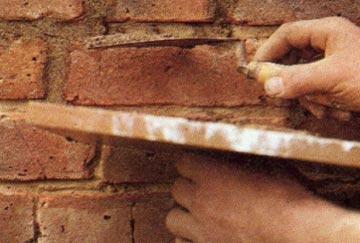
Repointing mortar joints where cracked and also when a brick has been replaced
One time your brickwork has been fabricated good using these solutions you lot can so proceed with your brick waterproofing using a skillful brick waterproofer such equally Dryseal waterproofer to damp proof your external walls and preclude any clammy and associated damage from occurring in the hereafter.
Damp Proof Your External Walls With Dryseal
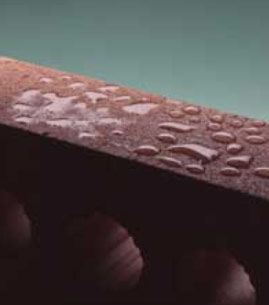
Dryseal waterproofer effectively waterproofs your brickwork
As we talked about earlier, hither at DIY Doc we just recommend using a brick waterproofer that allows your brickwork to breathe, as without this the damp already in your walls can't evaporate and allow your wall to dry out out. Dryseal waterproofer from PRS is both an effective and breathable conception, and so we tin recommend it for waterproofing your exterior walls.
Dryseal waterproofer is a solvent free, h2o-thinnable siloxane/silicone emulsion based clammy proofing paint. It is highly alkali resistant, is absorbed deeply into your brickwork and cures rapidly to form an constructive water repellent layer.
Information technology's water based and eco-friendly, and is too a great adhesive base for micro-porous paints.
You tin dilute Dryseal down and it will still reduce the water absorbance of your masonry without blocking the pores in the brick or rock, assuasive your clammy external walls to dry properly. Y'all can buy Dryseal waterproofer from PRS in their Damp Shop here.
Afterward you lot've waterproofed your outside walls you'll need to treat whatsoever clammy on your internal walls. If your plaster is sound, one time the walls have dried out you should exist able to treat them with a salt neutraliser or an anti-mould cleaner to get rid of any common salt deposits or mould spots earlier redecorating – both are available from PRS every bit well as anti-mould pigment.
If your plaster isn't audio, you'll demand to strip it back to 30cm above the highest damp indicate, wait for the wall to dry, treat it with a salt neutraliser or anti-mould cleaner and then replaster and redecorate.
If you want to be sure that your salts and mould won't render, you can apply a waterproof render or fit a mesh membrane to your wall before replastering.
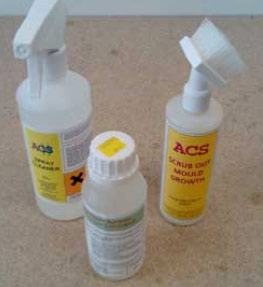
Treat your internal walls with anti-mould cleaner and common salt neutraliser earlier redecorating to forestall the reappearance of salt deposits and mould
If you lot're looking to clammy proof your internal walls because an surface area of your wall is below your damp proof grade, i.e. your floor level is beneath footing, you can do this past tanking, which involves applying a liquid or solid damp proof layer to your internal wall beneath your DPC. To find out more about tanking visit our Tanking project page.
As mentioned at the outset of this guide, if you need whatever assist with external brick waterproofing or whatever other attribute of damp proofing your external walls delight contact Property Repair Systems on 01626 872 650. Nosotros have worked with them on a number of projects over the years and they are specialists in this subject.
How To Repair Water Splash Upon Exterior Walls,
Source: https://www.diydoctor.org.uk/projects/waterproofing-external-masonry.htm
Posted by: curciworsir.blogspot.com


0 Response to "How To Repair Water Splash Upon Exterior Walls"
Post a Comment